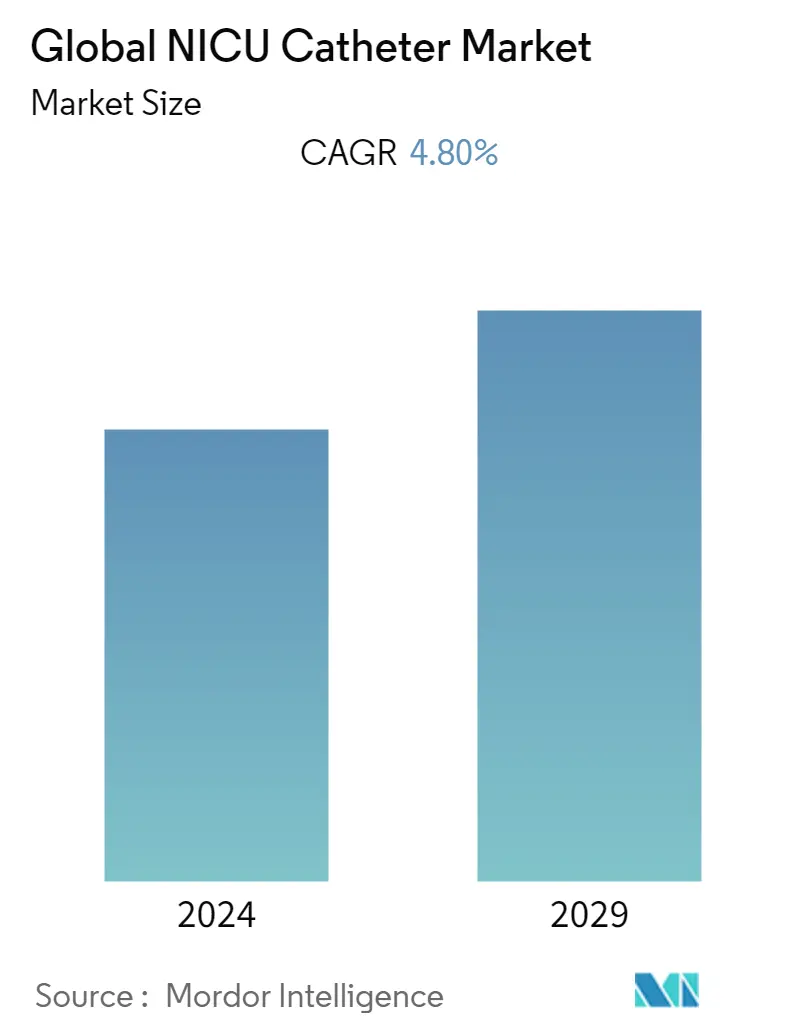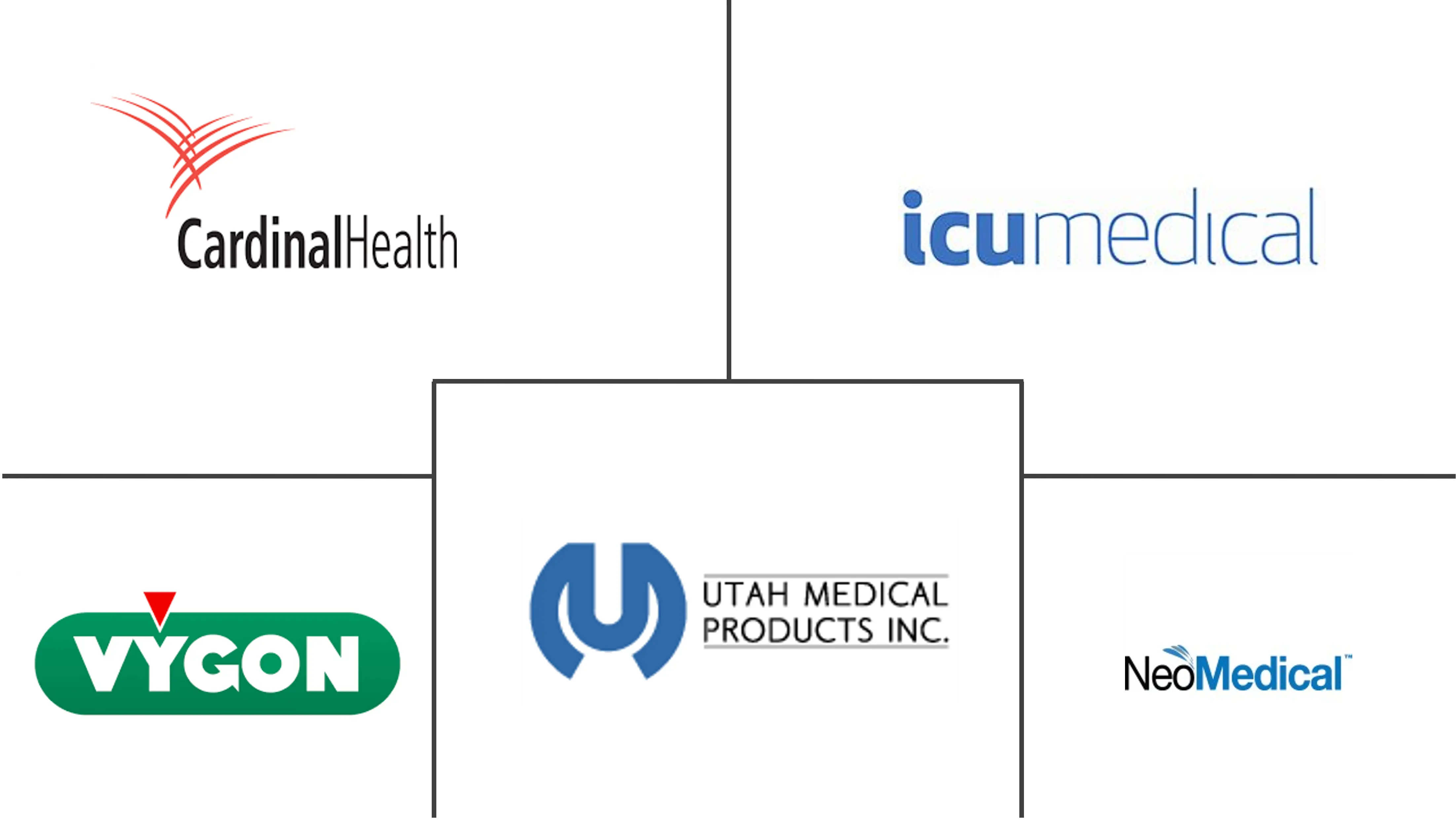Market Size of Global NICU Catheter Industry

| Study Period | 2019 - 2029 |
| Base Year For Estimation | 2023 |
| CAGR | 4.80 % |
| Fastest Growing Market | Asia-Pacific |
| Largest Market | North America |
| Market Concentration | Medium |
Major Players
*Disclaimer: Major Players sorted in no particular order |
NICU Catheter Market Analysis
The NICU catheter market is projected to register a CAGR of 4.8% during the forecast period (2022-2027).
During the rapidly evolving pandemic of COVID-19 infection in 2020-2021, pregnant women and their newborn infants with confirmed or suspected COVID-19 infections formed a special vulnerable group. They required immediate attention during the pandemic, such as resources for prevention of transmission, diagnosis of infection, and providing clinical care during labor, resuscitation, and postnatal period. Majorly procedures included endotracheal intubation, minimally invasive surfactant therapy (MIST), and umbilical catheter insertion. Also, some babies require continuous blood pressure (BP) monitoring which can be performed using a catheter in one of the baby's arteries. For instance, according to the Chinese Center for Disease Control and Prevention, 1,321 children tested positive for COVID-19 during the initial phase of the pandemic in 2020 in China. Out of which 18.1 % were less than one year of age. The neonates admitted to the neonatal intensive care unit (NICU) were critically ill from the SARS-CoV-2 infection and suffered from fever and poor feeding, thereby raising the demand for NICU catheters and contributing to the market growth.
Further, researchers found that neonates and young infants who tested positive for SARS-CoV-2 are more likely to develop sepsis-like syndrome (SLS). As per the research article published by National Center for Biotechnology Information (NCBI) in February 2021, a study was conducted in Hamad General Hospital (HGH), The State of Qatar, which included infants less than 8 weeks of age admitted with SLS between 1st April 2020 and 1st July 2020. They are tested for COVID-19 and found that around 40% of infants are COVID-19 positive. Neonatal sepsis is a major health problem that causes serious morbidity and mortality.
Hence, due to the above-mentioned reasons, the NICU catheter industry gained immense opportunities from the pandemic in neonatal coronavirus infection management, and currently, they are in extensive demand across all the regions.
The prevalence of premature deliveries is rising every year across the world. Premature birth is called when a baby is born before the completed 37 weeks of gestation. According to the Centers for Disease Control and Prevention (CDC), in the United States, the premature birth rate has been on an upward trajectory consistently, with 2019 being the fifth consecutive year in a row that the preterm rate increased. According to the World Health Organization (WHO), an estimated 15 million babies are born preterm every year, and this number is rising. Though there are no certain factors for preterm delivery, the researchers found that the social and economic factors have impacted most premature deliveries, such as unequal access to maternal care and high poverty rates. These reasons have increased a mother's risk of delivering prematurely. So, vascular access is essential in a premature baby for nutrition, taking blood, and delivery of medicines and fluids. Thus, various types of lines and catheters are used for vascular access, such as central venous, peripheral intravenous, umbilical venous, and peripherally inserted central venous catheters in premature babies. Since there is a surge in premature deliveries, there was a rapid growth in the demand for NICU catheters, thereby contributing to the market growth.
However, the risk of infection and stringent regulatory framework are major factors hindering the NICU catheter market's growth.
NICU Catheter Industry Segmentation
As per the scope of this report, the NICU catheter can be used as vascular access on a premature baby for nutrition, drawing blood, and delivery of medicines. For instance, an umbilical artery catheter (UAC) is used to draw blood from an infant at different times, without repeated needle sticks. Additionally, it can be used for a baby's blood pressure monitoring continuously. The NICU catheter market is segmented by product type (peripherally inserted central catheters (PICCs), central venous catheters (CVCs), umbilical venous catheters (UVCs), and others), end user (hospitals, specialty clinics, ambulatory surgical centers, and others) and geography (North America, Europe, Asia-Pacific, Middle-East and Africa, and South America). The market report also covers the estimated market sizes and trends for 17 different countries across major regions, globally. The report offers the value (in USD million) for the above segments.
| By Product Type | |
| Peripherally Inserted Central Catheters (PICCs) | |
| Central Venous Catheters (CVCs) | |
| Umbilical Venous Catheters (UVCs) | |
| Others |
| By End User | |
| Hospitals | |
| Specialty Clinics | |
| Ambulatory Surgical Centers | |
| Others |
| Geography | ||||||||
| ||||||||
| ||||||||
| ||||||||
| ||||||||
|
Global NICU Catheter Market Size Summary
The NICU catheter market is experiencing growth driven by several factors, including the rising prevalence of premature births and the increased demand for neonatal care solutions. The COVID-19 pandemic highlighted the vulnerability of pregnant women and newborns, leading to a surge in the need for NICU catheters for procedures such as endotracheal intubation and umbilical catheter insertion. The market is also benefiting from the growing awareness and management of neonatal conditions like sepsis-like syndrome, which has further fueled the demand for vascular access solutions. As the rate of premature deliveries continues to rise globally, the necessity for various types of catheters, including central venous and peripherally inserted central venous catheters, has become more pronounced, contributing to the market's expansion.
Regionally, Asia-Pacific is anticipated to witness significant growth due to its high preterm birth rates and the associated need for neonatal care. The region's maternal mortality rate, exacerbated by factors such as poverty and inadequate healthcare systems, has prompted government initiatives to enhance maternal and newborn health. This has created a favorable environment for the NICU catheter market to thrive. The market is moderately fragmented, with key players like ICU Medical Inc., Cardinal Health Inc., and Vygon SA leading the charge. Strategic moves, such as acquisitions and the introduction of training platforms for healthcare professionals, are expected to further strengthen the market's position and facilitate its growth trajectory over the forecast period.
Global NICU Catheter Market Size - Table of Contents
-
1. MARKET DYNAMICS
-
1.1 Market Overview
-
1.2 Market Drivers
-
1.2.1 Rise in Prevalence of Premature Deliveries
-
1.2.2 Increasing Mortality Rate of Maternal
-
-
1.3 Market Restraints
-
1.3.1 Risk of Infection
-
1.3.2 Stringent Regulatory Framework
-
-
1.4 Porter's Five Force Analysis
-
1.4.1 Threat of New Entrants
-
1.4.2 Bargaining Power of Buyers/Consumers
-
1.4.3 Bargaining Power of Suppliers
-
1.4.4 Threat of Substitute Products
-
1.4.5 Intensity of Competitive Rivalry
-
-
-
2. MARKET SEGMENTATION (Market Size by Value - USD million)
-
2.1 By Product Type
-
2.1.1 Peripherally Inserted Central Catheters (PICCs)
-
2.1.2 Central Venous Catheters (CVCs)
-
2.1.3 Umbilical Venous Catheters (UVCs)
-
2.1.4 Others
-
-
2.2 By End User
-
2.2.1 Hospitals
-
2.2.2 Specialty Clinics
-
2.2.3 Ambulatory Surgical Centers
-
2.2.4 Others
-
-
2.3 Geography
-
2.3.1 North America
-
2.3.1.1 United States
-
2.3.1.2 Canada
-
2.3.1.3 Mexico
-
-
2.3.2 Europe
-
2.3.2.1 Germany
-
2.3.2.2 United Kingdom
-
2.3.2.3 France
-
2.3.2.4 Italy
-
2.3.2.5 Spain
-
2.3.2.6 Rest of Europe
-
-
2.3.3 Asia-Pacific
-
2.3.3.1 China
-
2.3.3.2 Japan
-
2.3.3.3 India
-
2.3.3.4 Australia
-
2.3.3.5 South Korea
-
2.3.3.6 Rest of Asia-Pacific
-
-
2.3.4 Middle-East and Africa
-
2.3.4.1 GCC
-
2.3.4.2 South Africa
-
2.3.4.3 Rest of Middle-East and Africa
-
-
2.3.5 South America
-
2.3.5.1 Brazil
-
2.3.5.2 Argentina
-
2.3.5.3 Rest of South America
-
-
-
Global NICU Catheter Market Size FAQs
What is the current Global NICU Catheter Market size?
The Global NICU Catheter Market is projected to register a CAGR of 4.80% during the forecast period (2024-2029)
Who are the key players in Global NICU Catheter Market?
Cardinal Health Inc., ICU Medical Inc. (Smiths Medical, Inc.), Vygon SA and Utah Medical Products, Inc. are the major companies operating in the Global NICU Catheter Market.

